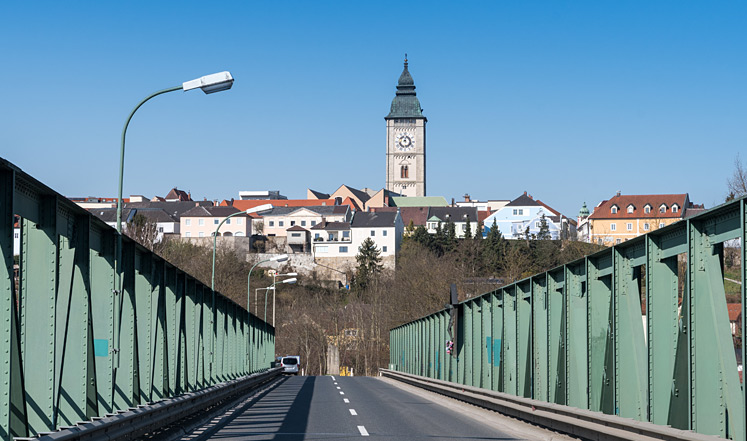
A Walk Through Enns Along The Via Lauriacum
By Reinhard Mandl*
The morning sun on my back
I am sitting in the Railjet Express 160 from Vienna to Linz, which flies through the landscape at up to 231 kilometres per hour on the new western line. Shortly after St. Valentin, the historic bell tower of Enns appears on the horizon to the left. It is a distinct landmark, rising up from the plateau upon which the old town is built. For the time being, I have to content myself with a glimpse through the train window because my train does not stop in Enns. I get off in Linz, where I change to an S1 regional express, which takes me back to Ennsdorf station on the old western railway line.
With the morning sun on my back, I walk along the river Enns toward the city until I come to the bridge and cross over. This sounds perfectly mundane nowadays, but after the Second World War, the demarcation line between the Soviet and the US occupation zones ran along here for ten years. This bridge became a hazardous barrier between the eastern and western parts of our country. Inspections at the Russian checkpoint in particular were dreaded and often arbitrary. For some compatriots, the short way over the Enns Bridge ended in a Soviet prison camp in Siberia.
I notice a memorial stone with the inscription “Lauricum Florianus, 4th May 304” in front of the “Enns” town sign. Florian von Lorch was a retired officer of the Roman army who had refused to renounce the Christian faith. At the time of the persecution of Christians under Emperor Diocletian, he was sentenced to death and thrown into the Enns with a stone around his neck.
I walk up the Wiener Berg hill toward the wall that surrounds the old town Stones from the Roman legion camp were used for its construction. In Wiener Strasse (Vienna Street), I look through a front gate at the massive arcades inside the former 16th-century royal castle, which has long since been turned into commercial and residential buildings.
Attractive façades line the Wiener Strasse as I head to the main square. The landmark of the city of Enns is the 60-meter-high bell tower, which was completed during an economic heyday in 1568 and replaced the dilapidated Scheibling Church. The Protestant citizens were able to forego a new church in this central location, but not a new tower. It is still used today as a clock tower and a bell tower, although the days when it served as a watchtower for the city of Enns are long past. Now, it has become an observation tower instead. There are 157 steps to climb. Those who make it all the way up, past the bells and the old clockwork, are rewarded with views in all directions and a birds-eye view of the terraced house fronts on the main square.
Many of these buildings are from the Late Gothic period, although their façades are mostly Baroque. Not infrequently, the new façades are significantly taller than the houses themselves. They were simply placed in front of the old façades and, standing on the sidewalk, I can see the sky through the upper windows of some buildings.
Right next to the city tower is the tourist information point, where I am told about a walk that follows in the footsteps of Roman history: The Via Lauriacum impressively conveys the dimensions of the Roman legionary camp, which was named after the much older Celtic settlement of Laurikon. Lauriacum served to protect the Danubian Limes, the northern border of the Roman Empire, and developed into the most important military base between Regensburg and Vienna. In 2021, the western section of the former Danubian Limes was included in the illustrious circle of world heritage sites.
The approximately two-hour walk takes me past all the important points of the ancient settlement. However, significant finds cannot be seen along the route, as they are on display in the Lauriacum Museum, which is home to one of the best Roman collections in Central Europe.
I walk past Ennsegg Castle and through the adjacent park to the Georgenberg, which forms the northernmost part of the Enns plateau. A Neolithic settlement once occupied this ridge, long before the Romans built a sanctuary on this striking terrain. The path continues past the former headquarters, or principia, of the legionary camp, where the bath and hospital were also located, and on to the Lorch district of Enns. Here, I find the most interesting point along the Via Lauriacum: the Basilica of St. Lawrence. The Gothic basilica emerged from a Romanesque church, which was built on the site of a noble Roman villa. The first church was built here towards the end of the 4th century and was one of the most important early Christian sites in Austria. The remains of this building can be viewed behind the altar. An ancient stone trough can be seen in the main altar itself. It contains the relics of St. Florian and other martyrs who had to die in Lauriacum in 304.
On the way back to the main square, I admire the beautiful old houses on Linzer Strasse. The final highlight of my visit is a tour of the Lauriacum Museum in the former town hall of Enns. It surprises with a variety of funerary reliefs, glass vessels, silver cups and Roman murals. I begin my journey home to Vienna from Enns station. First, I travel back to Linz, and from there a fast train takes me directly home.
On the way back to the main square, I admire the beautiful old houses on Linzer Strasse. The final highlight of my visit is a tour of the Lauriacum Museum in the former town hall of Enns. It surprises with a variety of funerary reliefs, glass vessels, silver cups and Roman murals. I begin my journey home to Vienna from Enns station. First, I travel back to Linz, and from there a fast train takes me directly home.
My timetable on the 21/03/2022:
depart from Vienna Central Station at 7:30 am, arrive in Enndorf at 9:13 am (via Linz) // depart from Enns at 4:31 pm, arrive in Vienna Central Station at 6:05 pm (via Linz)
(CO2 emission savings compared to driving in your own car: 73.60 kg)
* This text is an abridged version of chapter 4 of his book Discover Austria with the KlimaTicket – 20 Trips by Bus and Rail

















